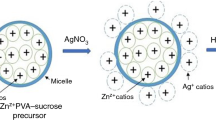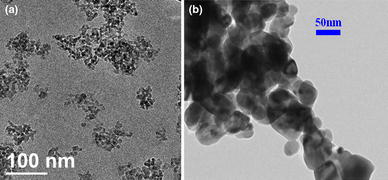Abstract
A novel glycol-based silver-coated zinc oxide (Ag/ZnO) hybrid nanofluids has been synthesized to investigate its thermo-physical properties with low volume concentrations (ϕ = 0.05% to ϕ = 0.2%) in comparison with ZnO nanofluids. The Ag/ZnO nanoparticles of size 25–40 nm are synthesized by chemical precursor method. The synthesized nanoparticles were characterized by scanning electron microscopy, transmission electron microscopy and X-ray diffraction analysis. The stability of the dispersed Ag/ZnO hybrid nanoparticles in glycol was observed visually and by zeta potential values. The thermal conductivity of the prepared nanofluids was measured experimentally by KD2 Pro, and maximum enhancement of 15.66% and 20.53% is reported at 25 °C and 55 °C, respectively, due to the coating of higher thermal conductivity Ag on the ZnO nanoparticles. An empirical correlation has been developed by the curve fitting technique to predict the thermal conductivity enhancement at different concentrations and temperatures. Also, experimentally measured results have been compared with the model developed by an artificial neural network. The correctness of the model has been evaluated by the R-squared value, mean square error, and average absolute relative deviation percent. Based on an experimental data test set of 104 samples, the ANN model consisting of 2 hidden layers with 10 neurons in each layer was the most accurate fit.










Similar content being viewed by others
Abbreviations
- Ag/ZnO:
-
Silver-coated zinc oxide nanoparticles
- EG:
-
Ethylene glycol
- k:
-
Thermal conductivity (W m−1 K−1)
- PVA:
-
Polyvinyl alcohol
- T:
-
Temperature of nanofluid
- XRD:
-
X-Ray diffraction
- ϕ:
-
Volume concentration of nanoparticles (%)
- bf:
-
Base fluid (ethylene glycol)
- nf:
-
Nanofluid
References
Choi SUS, Eastman JA. Enhancing thermal conductivity of fluids with nanoparticles. ASME Int Mech Eng Congr Expo [Internet]. 1995;66:99–105.
Maxwell JC. A treatise on electricity and magnetism, vol. I. 3rd ed. Oxford: Oxford unversity press; 1904.
Liu MS, Lin MCC, Tsai CY, Wang CC. Enhancement of thermal conductivity with Cu for nanofluids using chemical reduction method. Int J Heat Mass Transf. 2006;49:3028–33.
Ko GH, Heo K, Lee K, Kim DS, Kim C, Sohn Y, et al. An experimental study on the pressure drop of nanofluids containing carbon nanotubes in a horizontal tube. Int J Heat Mass Transf. 2007;50:4749–53.
Ghadimi A, Metselaar IH. The influence of surfactant and ultrasonic processing on improvement of stability, thermal conductivity and viscosity of titania nanofluid. Exp Therm Fluid Sci [Internet]. 2013;51:1–9. https://doi.org/10.1016/j.expthermflusci.2013.06.001.
Asadi A, Asadi M, Siahmargoi M, Asadi T, Gholami Andarati M. The effect of surfactant and sonication time on the stability and thermal conductivity of water-based nanofluid containing Mg(OH)2nanoparticles: an experimental investigation. Int J Heat Mass Transf [Internet]. 2017;108:191–8. https://doi.org/10.1016/j.ijheatmasstransfer.2016.12.022.
Hwang Y, Lee JK, Lee CH, Jung YM, Cheong SI, Lee CG, et al. Stability and thermal conductivity characteristics of nanofluids. Thermochim Acta. 2007;455:70–4.
Nabeel Rashin M, Hemalatha J. A novel ultrasonic approach to determine thermal conductivity in CuO-ethylene glycol nanofluids. J Mol Liq [Internet]. 2014;197:257–62. https://doi.org/10.1016/j.molliq.2014.05.024.
Sarkar J, Ghosh P, Adil A. A review on hybrid nano fl uids: recent research, development and applications. Renew Sustain Energy Rev [Internet]. 2015;43:164–77. https://doi.org/10.1016/j.rser.2014.11.023.
Sundar LS, Sharma KV, Singh MK, Sousa ACM. Hybrid nanofluids preparation, thermal properties, heat transfer and friction factor—a review. Renew Sustain Energy Rev [Internet]. 2017;68:185–98.
Suresh S, Venkitaraj KP, Selvakumar P, Chandrasekar M. Synthesis of Al2O3-Cu/water hybrid nanofluids using two step method and its thermo physical properties. Colloids Surf A Physicochem Eng Asp [Internet]. 2011;388:41–8. https://doi.org/10.1016/j.colsurfa.2011.08.005.
Hemmat Esfe M, Abbasian Arani AA, Rezaie M, Yan WM, Karimipour A. Experimental determination of thermal conductivity and dynamic viscosity of Ag-MgO/water hybrid nanofluid. Int Commun Heat Mass Transf [Internet]. 2015;66:189–95. https://doi.org/10.1016/j.icheatmasstransfer.2015.06.003.
Sundar LS, Singh MK, Sousa ACM. Enhanced heat transfer and friction factor of MWCNT-Fe3O4/water hybrid nanofluids. Int Commun Heat Mass Transf [Internet]. 2014;52:73–83. https://doi.org/10.1016/j.icheatmasstransfer.2014.01.012.
Eshgarf H, Sina N, Esfe MH, Izadi F, Afrand M. Prediction of rheological behavior of MWCNTs–SiO2/EG–water non-Newtonian hybrid nanofluid by designing new correlations and optimal artificial neural networks. J Therm Anal Calorim [Internet]. 2018;132:1029–38. https://doi.org/10.1007/s10973-017-6895-y.
Yarmand H, Gharehkhani S, Ahmadi G, Shirazi SFS, Baradaran S, Montazer E, et al. Graphene nanoplatelets-silver hybrid nanofluids for enhanced heat transfer. Energy Convers Manag [Internet]. 2015;100:419–28. https://doi.org/10.1016/j.enconman.2015.05.023.
Akhgar A, Toghraie D. An experimental study on the stability and thermal conductivity of water-ethylene glycol/TiO2-MWCNTs hybrid nanofluid: developing a new correlation. Powder Technol [Internet]. 2018;338:806–18. https://doi.org/10.1016/j.powtec.2018.07.086.
Baby TT, Ramaprabhu S. Synthesis and nanofluid application of silver nanoparticles decorated graphene. J Mater Chem. 2011;21:9702–9.
Tadjarodi A, Zabihi F. Thermal conductivity studies of novel nanofluids based on metallic silver decorated mesoporous silica nanoparticles. Mater Res Bull [Internet]. 2013;48:4150–6. https://doi.org/10.1016/j.materresbull.2013.06.043.
Parsian A, Akbari M. New experimental correlation for the thermal conductivity of ethylene glycol containing Al2O3–Cu hybrid nanoparticles. J Therm Anal Calorim. 2017;131:1605–13.
Hemmat M, Mousa E, Rostam R. Estimation of thermal conductivity of ethylene glycol-based nanofluid with hybrid suspensions of SWCNT—Al2O3 nanoparticles by correlation and ANN methods using experimental data. J Therm Anal Calorim. 2017;128:1359–71.
Hemmat Esfe M, Abbasian Arani AA, Shafiei Badi R, Rejvani M. ANN modeling, cost performance and sensitivity analyzing of thermal conductivity of DWCNT–SiO2/EG hybrid nanofluid for higher heat transfer: an experimental study. J Therm Anal Calorim. 2018;131:2381–93.
Rostamian SH, Biglari M, Saedodin S, Hemmat Esfe M. An inspection of thermal conductivity of CuO-SWCNTs hybrid nanofluid versus temperature and concentration using experimental data, ANN modeling and new correlation. J Mol Liq [Internet]. 2017;231:364–9. https://doi.org/10.1016/j.molliq.2017.02.015.
Esfe MH, Behbahani PM, Akbar A, Arani A, Sarlak MR. Thermal conductivity enhancement of SiO 2—MWCNT (85: 15%)–EG hybrid nanofluids. J Therm Anal Calorim. 2017;128:249–58.
Esfe MH. Thermal conductivity of Cu/TiO2–water/EG hybrid nanofluid: experimental data and modeling using artificial neural network and correlation. Int Commun Heat Mass Transf. 2015;66:100–4. https://doi.org/10.1016/j.icheatmasstransfer.2015.05.014.
Safaei MR, Hajizadeh A, Afrand M, Qi C, Yarmand H, Zulkifli NWBM. Evaluating the effect of temperature and concentration on the thermal conductivity of ZnO-TiO2/EG hybrid nanofluid using artificial neural network and curve fitting on experimental data. Phys A Stat Mech Appl. 2019;519:209–16.
Keyvani M, Afrand M, Toghraie D, Reiszadeh M. An experimental study on the thermal conductivity of cerium oxide/ethylene glycol nanofluid: developing a new correlation. J Mol Liq. 2018;266:211–7.
Alrashed AAAA, Gharibdousti MS, Goodarzi M, de Oliveira LR, Safaei MR, Bandarra Filho EP. Effects on thermophysical properties of carbon based nanofluids: Experimental data, modelling using regression, ANFIS and ANN. Int J Heat Mass Transf. 2018;125:920–32.
Esfe MH, Afrand M, Rostamian SH, Toghraie D. Examination of rheological behavior of MWCNTs/ZnO-SAE40 hybrid nano-lubricants under various temperatures and solid volume fractions. Exp Therm Fluid Sci [Internet]. 2016. https://doi.org/10.1016/j.expthermflusci.2016.07.011.
Hemmat Esfe M, Rostamian H, Toghraie D, Yan WM. Using artificial neural network to predict thermal conductivity of ethylene glycol with alumina nanoparticle: Effects of temperature and solid volume fraction. J Therm Anal Calorim. 2016;126:643–8.
Hemmat Esfe M, Ahangar MRH, Toghraie D, Hajmohammad MH, Rostamian H, Tourang H. Designing artificial neural network on thermal conductivity of Al2O3–water–EG (60–40%) nanofluid using experimental data. J Therm Anal Calorim. 2016;126:837–43.
Jadhav J, Biswas S. Structural and electrical properties of ZnO: Ag core-shell nanoparticles synthesized by a polymer precursor method. Ceram Int [Internet]. 2016;42:16598–610. https://doi.org/10.1016/j.ceramint.2016.07.081.
Barewar SD, Chougule SS, Jadhav J, Biswas S. Synthesis and thermo-physical properties of water-based novel Ag/ZnO hybrid nanofluids. J Therm Anal Calorim. 2018;134:1493–504.
Jadhav J, Biswas S. Surface plasmon enhanced near-UV emission in monodispersed ZnO: Ag core-shell type nanoparticles synthesized by a wet chemical method. Superlattices Microstruct [Internet]. 2016;91:8–21. https://doi.org/10.1016/j.spmi.2015.12.040.
Barewar SD, Chougule SS, Jadhav J, Biswas S. Synthesis and characterization of water based ZnO and Ag coated ZnO nanofluids for heat transfer applications References; 2017. p. 231.
Shahsavar A, Khanmohammadi S, Toghraie D, Salihepour H. Experimental investigation and develop ANNs by introducing the suitable architectures and training algorithms supported by sensitivity analysis: measure thermal conductivity and viscosity for liquid paraffin based nanofluid containing Al2O3 nanoparticles. J Mol Liq. 2019;276:850–60.
Keblinski P, et al. Mechanisms of heat flow in suspensions of nanosized particles nanofluids). Int J Heat Mass Transf. 2002;45:855–63.
Kannaiyan S, Boobalan C, Nagarajan FC, Sivaraman S. Modeling of thermal conductivity and density of alumina/silica in water hybrid nanocolloid by the application of Artificial Neural Networks. Chin J Chem Eng. 2018;27:726–36.
Hemmat Esfe M, Hassani Ahangar MR, Rejvani M, Toghraie D, Hajmohammad MH. Designing an artificial neural network to predict dynamic viscosity of aqueous nanofluid of TiO2 using experimental data. Int Commun Heat Mass Transf. 2016;75:192–6.
Tahani M, Vakili M, Khosrojerdi S. Experimental evaluation and ANN modeling of thermal conductivity of graphene oxide nanoplatelets/deionized water nanofluid. Int Commun Heat Mass Transf. 2016;76:358–65.
Hemmat Esfe M, Yan WM, Afrand M, Sarraf M, Toghraie D, Dahari M. Estimation of thermal conductivity of Al2O3/water (40%)-ethylene glycol (60%) by artificial neural network and correlation using experimental data. Int Commun Heat Mass Transf [Internet]. 2016;74:125–8. https://doi.org/10.1016/j.icheatmasstransfer.2016.02.002.
Author information
Authors and Affiliations
Corresponding author
Additional information
Publisher's Note
Springer Nature remains neutral with regard to jurisdictional claims in published maps and institutional affiliations.
Rights and permissions
About this article
Cite this article
Barewar, S.D., Tawri, S. & Chougule, S.S. Experimental investigation of thermal conductivity and its ANN modeling for glycol-based Ag/ZnO hybrid nanofluids with low concentration. J Therm Anal Calorim 139, 1779–1790 (2020). https://doi.org/10.1007/s10973-019-08618-6
Received:
Accepted:
Published:
Issue Date:
DOI: https://doi.org/10.1007/s10973-019-08618-6




